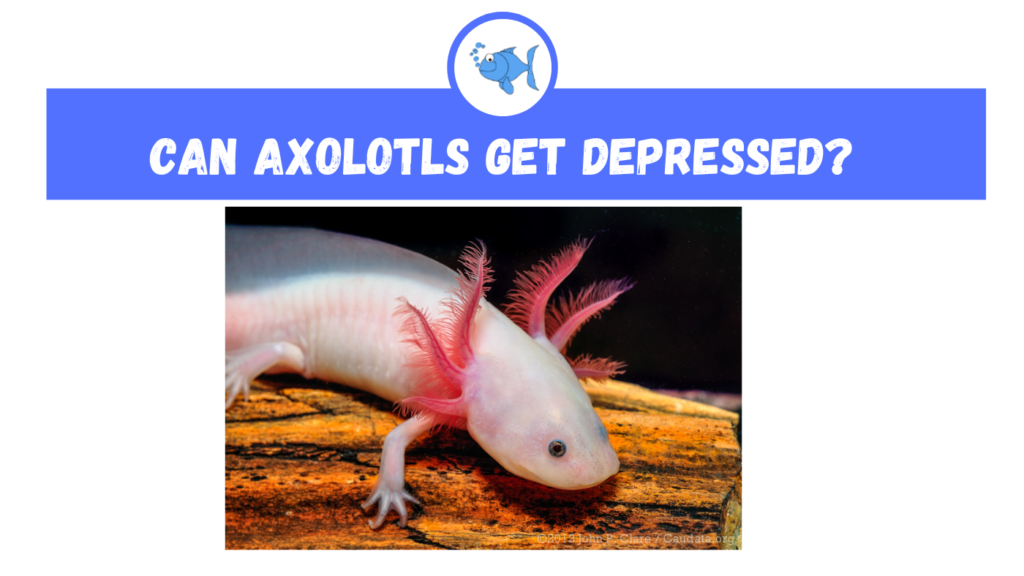If you have an axolotl, you probably want to make sure they have a healthy, happy life. Due to their timid nature, it can be hard to gauge how your axolotl is feeling. You might even start to think that they are sad. In today’s article, I will answer the question can axolotls get depressed?
Can Axolotls Get Depressed?
No, axolotls do not get depressed. Even in the wild they are solitary creatures, and typically don’t interact a lot with each other or other species.
It’s important to realize that axolotls do not have the same demeanor as other pet fish. Since axolotls aren’t big swimmers and spend a lot of their time just sitting around, it might seem like they are depressed or sad. The truth is they just prefer to sit around most of the time.
While axolotls don’t get depressed, you might be wondering if they feel lonely if they live by themselves.
Do axolotls get lonely if they live alone?
To answer the question, no, your axolotl won’t get lonely if they live alone. However, that doesn’t mean you should only get one axolotl.
While I can only speak based on my personal experience, I have two axolotls and they certainly enjoy each other’s company. I have a 75 gallon tank, and they still manage to be next to each other most of the time.
I have read online that axolotls only interact with each other in the wild when they mate. While that might be true, I would still encourage you to get more than 1 axolotl if you have a big enough tank.
While axolotls don’t get depressed, axolotls can certainly get stressed. There are a variety of reasons why your axolotl might be stressed, and it’s important to recognize the signs.
How to prevent your axolotl from being bored
While axolotls aren’t very active swimmers, they do like very large tanks. A general rule of thumb is to have at least 20 gallons of water for each axolotl. So if you have two axolotls, you should try to have a tank of at least 40 gallons.
I also suggest that you add some decorations to your tank. Axolotls like to hide, so I suggest adding ornaments that are big enough for them to crawl and swim under. A cheap way to do this is by adding short pvc pipes to your tank. You can also buy some large rock decorations for them to hide under.

While axolotls do prefer calmer water without a lot of movement, some are known to really like bubbles. For example, they will often times crawl next to a filter or bubbler.

If you want to spice up your tank and give your axolotl more stimulation, you should buy a bubbler like the one pictured above.
Lastly, you can help stimulate your axolotl by feeding them live bait.
Related: How long can an axolotl go without eating?
How to tell if your axolotl is stressed
A stressed axolotl will display a variety of behaviors, including a lack of movement, change in appetite, taking a lot of gulps of air, and erratic movements.
Additionally, a stressed axolotl might also start to curl their gills. This usually results in their gills turning inward towards their face. They might also start to curl their tails.
Now that you know the signs of a stressed axolotl, you should know what causes them to be stressed.
What causes a axolotl to get stressed?
The main cause of stress for an axolotl is poor water conditions. Usually this is a result of a warm water temperature. Your axolotl can also get stressed if they don’t have a filter.
Axolotls require a water temperature in the mid 60s. If your water temperature reaches 70 degrees farenheight or more, it can cause serious health problems. Unfortunately, it can be hard to keep your tank at a low enough temperature.
An expensive way to keep your tank cold enough is to use a tank chiller. However, these can be pretty expensive. Cheaper ways to keep their tank cold include directing a fan to the top of the water, removing the lid of your fish tank, and reducing the amount of light in your tank.
A cloudy axolotl tank can also make your axolotl stressed. You can help prevent this by using a high powered filter.
